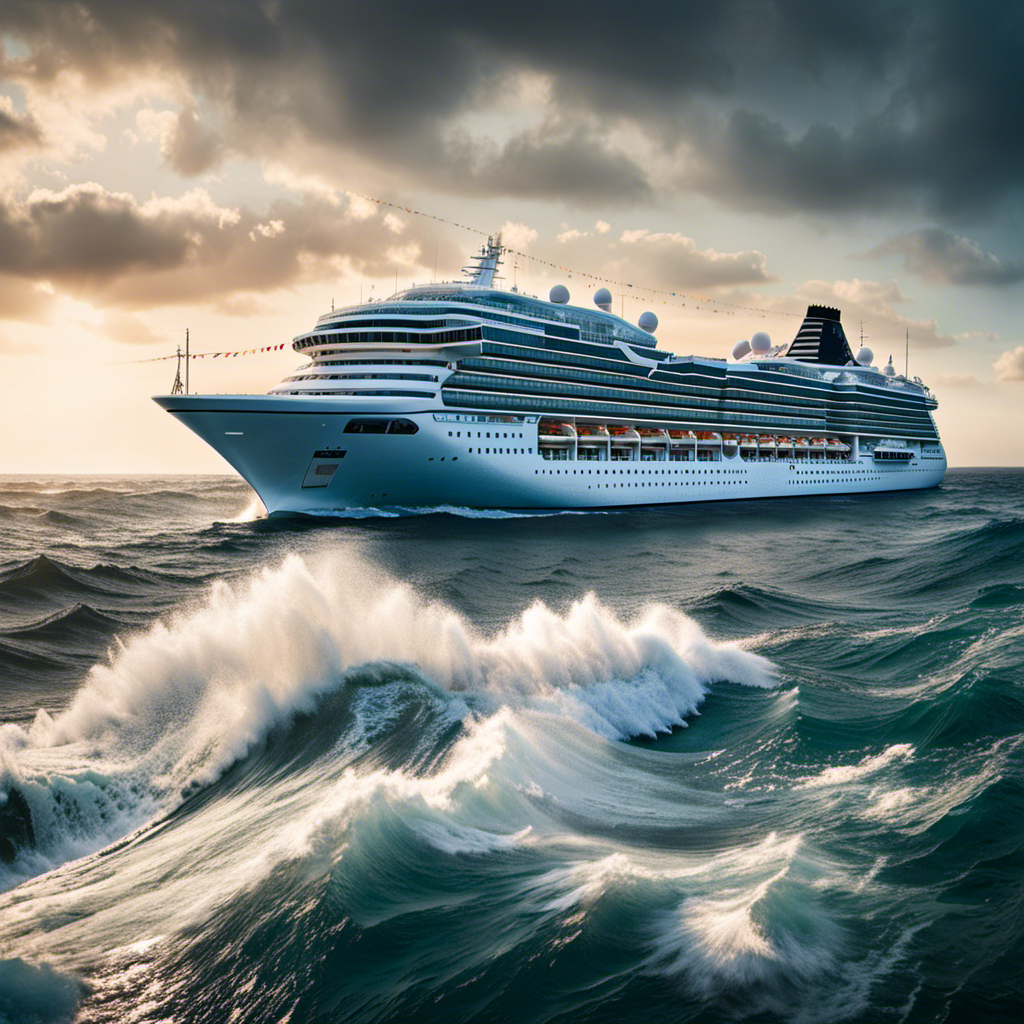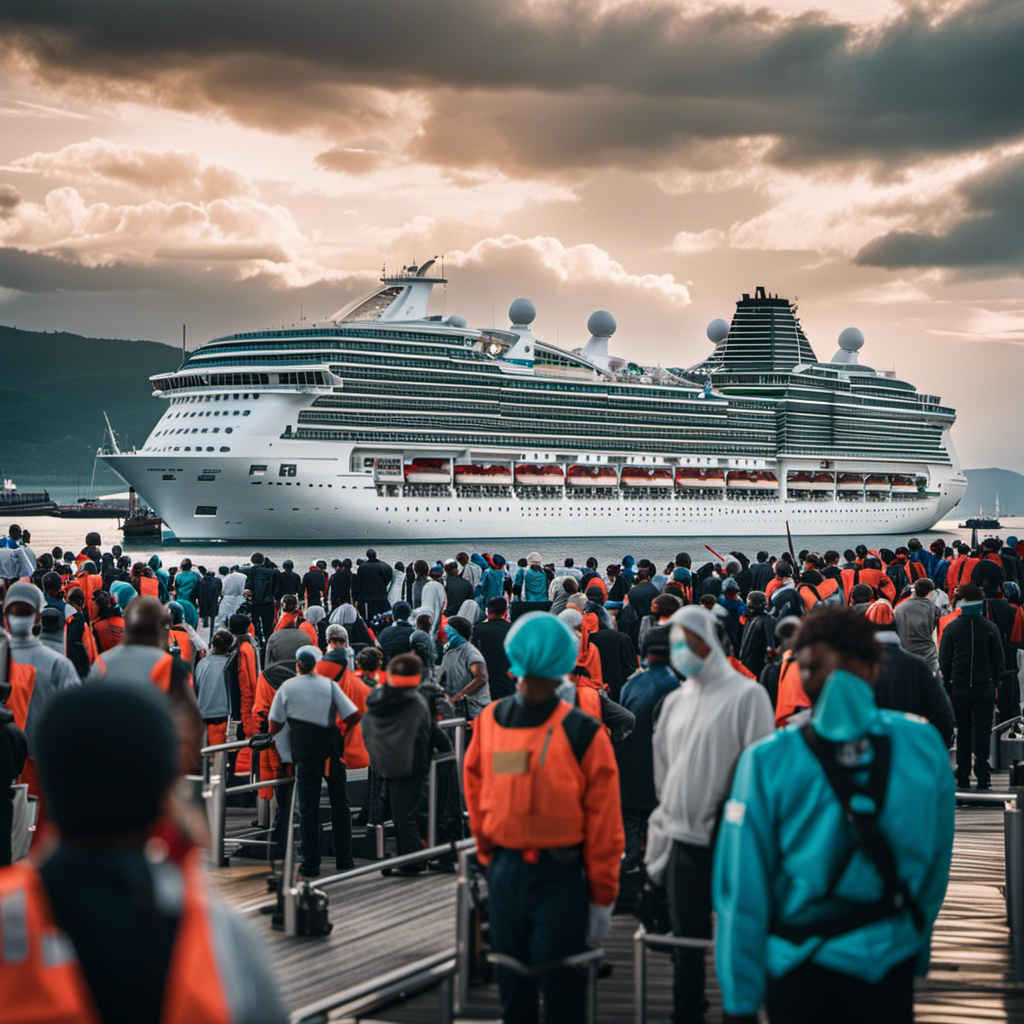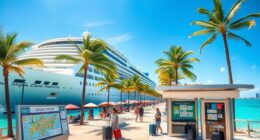As I step onto the cruise ship, I’m engulfed by feelings of excitement and nervousness. The arrival of the Omicron variant has introduced notable challenges for the cruise industry. Even though there have been instances of infection among the passengers and crew, the occupancy rate of the ship continues to climb steadily.
With high vaccination rates and rigorous testing protocols in place, the positive rate remains lower than on land. However, the fear of temporary port closures looms, emphasizing the need for transparency and data sharing.
Join me as we explore the impact of Omicron and the success of vaccinations in the cruise industry.
Key Takeaways
- Omicron cases have increased globally, including on cruise ships.
- The number of cruise ships with non-green status has sharply increased.
- Occupancy levels on Royal Caribbean ships have gradually increased but are still below pre-pandemic norms.
- Vaccination rates among passengers and crew on Royal Caribbean ships are high.
Surge in Omicron Cases on Cruise Ships
I’ve noticed a surge in Omicron cases on cruise ships, including the Symphony of the Seas and Norwegian Breakaway.
This is challenging for the cruise industry as they try to navigate the impact of the highly transmissible variant.
The Centers for Disease Control and Prevention (CDC) tracks cases on cruise ships and assigns color statuses based on conditions. Lately, the number of ships with non-green status has sharply increased, indicating the presence of COVID-19 cases.
Despite implementing strict vaccination and testing protocols, the cruise industry is still facing difficulties in preventing the spread of the virus.
These challenges highlight the need for continued vigilance and adherence to safety measures to protect passengers and crew members onboard cruise ships.
Occupancy Levels and Recovery Progress
Currently, occupancy levels on Royal Caribbean ships have gradually increased from 20-30% in July to 70-80%. This is a positive sign indicating recovery progress in the cruise industry.
The increase in occupancy levels can be attributed to the success of vaccination efforts among passengers and crew members. Royal Caribbean requires vaccination for those over 12 years old and crew members, with vaccination rates in the mid-to-high 90% range. Additionally, guests are tested before boarding the ship, and crew members interacting with passengers are tested every three days. These vaccination and testing protocols have helped ensure the safety of everyone on board.
It is important to note that the current occupancy levels are still below pre-pandemic norms, as the cruise line’s normal full-year load factor is approximately 110%. However, the steady increase in occupancy levels reflects the vaccination success and the industry’s commitment to providing a safe and enjoyable cruise experience.
Vaccination and Testing Protocols on Cruise Ships
The high vaccination rates on Royal Caribbean ships contribute to a safe and secure environment for passengers and crew members. This is achieved through stringent vaccination and testing protocols that prioritize the health and well-being of everyone on board. Here are three key aspects of these protocols:
-
Vaccination effectiveness: Vaccination is required for all passengers over 12 years old and crew members. The vaccination rates on Royal Caribbean ships are in the mid-to-high 90% range, ensuring a high level of protection against COVID-19. Most positive cases on the ship are among fully vaccinated individuals, with over 99% being asymptomatic or experiencing mild symptoms. This demonstrates the effectiveness of vaccination in preventing severe illness.
-
Testing frequency: To further mitigate the risk of infection, crew members interacting with passengers are tested every three days. Guests are also tested before boarding the ship, providing an additional layer of safety. Regular testing helps identify and isolate any potential cases, minimizing the spread of the virus and maintaining a healthy environment on board.
Positive Rates Comparison: Ship Vs. Land
Compared to the land, the positive rate on Royal Caribbean ships remains significantly lower. The cruise line has implemented strict vaccination and testing protocols to mitigate the transmission of COVID-19 onboard. With high vaccination rates among passengers and crew, the positive rate on the ship is much lower than on land.
In fact, some ships have a positivity rate close to 1%, which is significantly lower than the 5% positivity rate in Florida. Even in larger outbreaks, the percentage of positive cases remains low. This suggests that the safety measures and protocols in place on Royal Caribbean ships are effective in preventing the spread of the virus.
Mild Cases Among Vaccinated Passengers
I have observed that most positive cases among passengers on Royal Caribbean ships are among fully vaccinated individuals. This analysis of mild cases among vaccinated passengers provides valuable insights into their experiences on the cruise ships:
- Majority of positive cases are asymptomatic or have mild symptoms.
- The virus seems to have become more like a mild cold for vaccinated individuals.
- Transparency and data sharing from other cruise lines and the CDC are desired.
These findings highlight the effectiveness of vaccinations in reducing the severity of COVID-19 among cruise ship passengers. It is reassuring to know that the majority of vaccinated individuals experience only mild symptoms or no symptoms at all. However, it is important for cruise lines to continue implementing safety measures and closely monitor the situation to ensure the well-being of all passengers and crew members.
Transparency and data sharing can contribute to a better understanding of the overall impact of COVID-19 on cruise ships.
Temporary Port Closures and Impact on Itineraries
Fortunately, temporary port closures have not significantly disrupted itineraries on Royal Caribbean ships. While there have been instances of ports temporarily closing due to elevated positivity rates, the impact on the cruise line’s itineraries has been minimal.
Royal Caribbean has implemented robust protocols to ensure the safety of its passengers and crew, including high vaccination rates and regular testing. These measures have helped to keep positive rates on the ships lower than on land, with most cases being asymptomatic or mild.
In the event of a temporary port closure, the cruise line has contingency plans in place to modify itineraries and provide alternative port options. This proactive approach has allowed Royal Caribbean to continue providing enjoyable and safe experiences for its guests, even in the face of temporary disruptions.
The Need for Transparency and Data Sharing in the Cruise Industry
Transparency and data sharing among cruise lines and the CDC are crucial for effectively monitoring and addressing the impact of elevated positivity rates and potential disruptions in the industry. It is imperative that cruise lines openly share data on cases, outbreaks, and vaccination rates to ensure the safety and well-being of passengers and crew.
However, there are challenges in achieving this transparency. Some cruise lines may be hesitant to disclose information due to concerns about the negative impact on their reputation and bookings. Additionally, data sharing initiatives between cruise lines and the CDC may face logistical and regulatory hurdles.
Overcoming these transparency challenges is essential for the industry to proactively respond to emerging situations, implement appropriate safety measures, and maintain the trust of passengers.
Frequently Asked Questions
How Many Reported Cases of the Omicron Variant Have Been Identified on Cruise Ships Globally?
I can’t provide an accurate answer to the current question without the context of Cruise Ship Challenges: Omicron Impact and Vaccination Success. The context is necessary to provide specific information about reported cases on cruise ships globally.
What Are the Current Occupancy Levels on Royal Caribbean Ships and How Do They Compare to Pre-Pandemic Levels?
Currently, the occupancy levels on Royal Caribbean ships are at 70-80%, which is an increase from the 20-30% in July. However, it is still below the pre-pandemic levels of approximately 110%.
Are There Any Additional Vaccination Requirements or Protocols in Place for Crew Members on Royal Caribbean Ships?
Yes, there are additional vaccination requirements and protocols for crew members on Royal Caribbean ships. Vaccination is mandatory for crew members, and they also undergo regular testing every three days.
How Does the Positivity Rate on Royal Caribbean Ships Compare to the Positivity Rate on Land, Specifically in Florida?
The positivity rate on Royal Caribbean ships is lower than on land, specifically in Florida. Some ships have a positivity rate close to 1%, while Florida’s rate is 5%.
What Measures Are in Place to Address Temporary Port Closures Due to Elevated Positivity Rates, and How Do These Closures Impact the Itineraries of Cruise Ships?
Temporary port closures due to elevated positivity rates are addressed by implementing strict testing protocols and safety measures. These closures can impact cruise ship itineraries, leading to itinerary changes or alternative destinations being chosen to ensure passenger safety and minimize disruptions.
Meet Asra, a talented and adventurous writer who infuses her passion for exploration into every word she writes. Asra’s love for storytelling and her insatiable curiosity about the world make her an invaluable asset to the Voyager Info team.
From a young age, Asra was drawn to the power of words and their ability to transport readers to far-off lands and magical realms. Her fascination with travel and cultures from around the globe fueled her desire to become a travel writer, and she set out on a journey to turn her dreams into reality.











